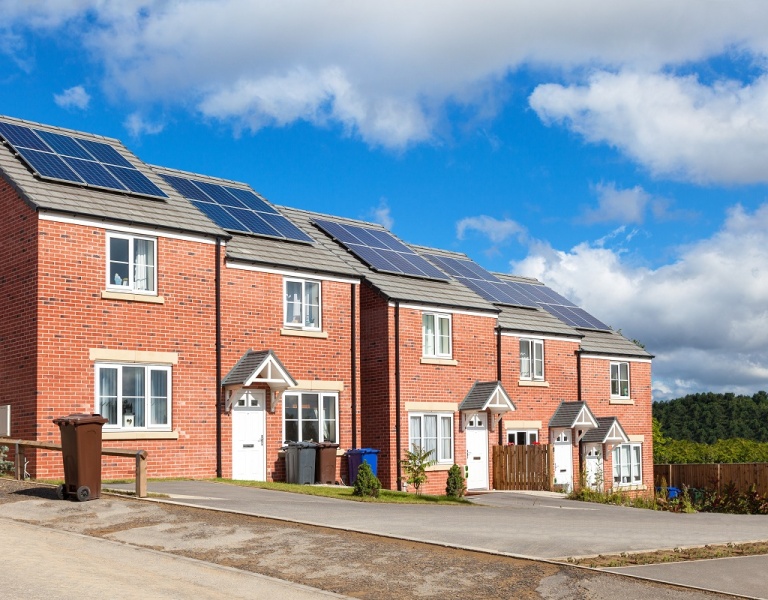Solar PV grant
A new scheme has been introduced that offers homeowners a grant towards the cost of installing solar photovoltaics for producing electricity in their own home.
Solar photovoltaics helps reduce the amount of electricity you use from the grid by converting energy from the sun into electricity. Solar photovoltaics panels do not heat your house or water. If you are looking for panels to heat your water then you require a different type of panel called solar tube panels.
To help homeowners decide if solar PV panels are for them, we spoke to Brian O' Mahony who works in our energy efficiency team about the most commonly asked questions he is asked about solar panels.

Does Ireland get enough sun for solar panels to be efficient?
The short answer is yes. While Ireland does have its fair amount of rain, the solar PV systems generate electricity in daylight. That means they still function on overcast days. Solar panels will always perform their best in direct sunlight. A well located 1.8kWp system (6 panel) could generate around 1,500kWh of electricity a year. That is about one-third of the typical annual electricity demand of an Irish home.
What country has embraced solar panels the most in the world?
China is the leader in solar PV generation, you will see this as utility scale systems which people call solar farms. Closer to home, in the UK, you will see lots of buildings and homes with solar pv panels installed on roofs. People generally install solar pv panels to meet some of their energy needs, help the environment and reduce their carbon footprint.
How much is a solar panel on average to install and what is the payback?
The cost of purchasing and installing solar panels has come down considerably over the last 10 years. The cost of a solar PV system depends on a range of factors including the hardware chosen, size of system, monitoring equipment and the structure and type of roof or site.
To date in the scheme we are seeing costs ranging from €2,000 to €3,300 per kWp including VAT but prices will vary depending on the factors mentioned above.
How much electricity will I use from solar panels versus what I use from my electricity provider?
The best systems for people are ones where most of the energy is used within your home, rather that spilling onto the grid or exported, as you get the best value for the electricity. So generally this means installing a system that will provide about one-third of your electricity needs. If you want to go beyond that you will need to install a storage system (essentially a battery) which will allow you use the solar electricity when the sun is not shining (i.e. at night).
Do I need planning permission for solar panels?
Solar PV systems installed in a domestic setting under 12 sq. m (about a 1.5kWp to 1.8kWp system) and representing less than 50% of the total roof area are exempt from planning. There are some specific requirements about planning, so it is best to contact your local authority.
Where do I find an installer?
SEAI has a list of installers here. These are installers who have completed a solar PV course and are a Registered Electric Contractor with Safe Electric Ireland.
Can I sell my electricity back to the grid?
There are not currently any energy suppliers who will pay you for the electricity you generate and export to the grid in Ireland at the moment. It is likely that EU directives will change this in the coming years. But I would point people back to the fact that it is more valuable to use the electricity within your home than get a payment for it, so self-consumption is the key.
My roof doesn't face south and I've heard this is the best direction for solar panels - does this matter?
South is best in the respect that it will generate the most electricity, but other orientations can also work. East facing panels will generate most of their energy before midday, but they still will work in the afternoon but will not generate to the same level. East-west facing panels may suit the use pattern over people's home, where they are home in mornings or evenings and out during day.
The panel orientation is one of the things your installer will discuss at the start and they will want to know your energy bills and also your typical use pattern so they can optimize the system design for you.
What about shading from trees and chimneys?
Shading can be a problem from trees or chimneys and so the panels should be installed to avoid any potential shading. It's also important to think about whether existing trees will grow and possibly block the panels in the future or if you are installing during the autumn/winter when there are no leaves present.
Your installer will be able advise you on the best way to deal with shading.
What maintenance is needed?
It generally consists of keeping panels clean but our weather with rain helps a lot. Installers generally offer maintenance services and many systems today have apps where you can monitor your systems performance with your mobile phone. In about 10 or so years you will need to replace the inverter.
How long does it take to install?
Ideally, it should not take any longer than a day to install after initial inspection by contractors.
How long do they last?
The whole system typically has a design life of over 20 years. There are no moving parts so typically the systems just work away.